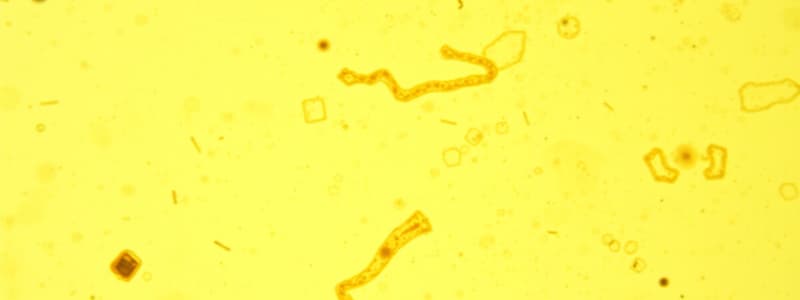Podcast
Questions and Answers
What type of fermentation pathway does Leuconostoc species primarily use?
What type of fermentation pathway does Leuconostoc species primarily use?
- Alcoholic fermentation pathway
- Heterolactic pathway (correct)
- Homolactic pathway
- Lactic acid pathway
Which of the following products is NOT commonly produced by Leuconostoc species?
Which of the following products is NOT commonly produced by Leuconostoc species?
- Buttermilk
- Red wine (correct)
- Sauerkraut
- Pickles
What is the primary purpose of adding 2.25-2.5% salt to shredded cabbage in the sauerkraut fermentation process?
What is the primary purpose of adding 2.25-2.5% salt to shredded cabbage in the sauerkraut fermentation process?
- To inhibit spoilage organisms (correct)
- To increase lactic acid production
- To enhance the flavor
- To promote aerobic fermentation
What is synthesized by L.mesenteroides from sucrose, contributing to industrial applications?
What is synthesized by L.mesenteroides from sucrose, contributing to industrial applications?
What is the net ATP produced from the ribose pathway during fermentation?
What is the net ATP produced from the ribose pathway during fermentation?
Which component is part of fibrous plant material commonly fermented in the rumen?
Which component is part of fibrous plant material commonly fermented in the rumen?
What type of fermentation predominates in the production of sauerkraut?
What type of fermentation predominates in the production of sauerkraut?
What is the typical volume of the rumen in liters?
What is the typical volume of the rumen in liters?
What process is primarily responsible for producing lactic acid in homofermentative bacteria?
What process is primarily responsible for producing lactic acid in homofermentative bacteria?
Which food product is NOT typically associated with lactic acid fermentation?
Which food product is NOT typically associated with lactic acid fermentation?
In the production of silage, what happens to the pH during fermentation?
In the production of silage, what happens to the pH during fermentation?
Which of the following is a characteristic of heterofermentative lactic acid bacteria?
Which of the following is a characteristic of heterofermentative lactic acid bacteria?
What is the main role of lactic acid bacteria in food preservation?
What is the main role of lactic acid bacteria in food preservation?
Which lactic acid bacterium can be sensed when using L.delbrueckii in fermentation?
Which lactic acid bacterium can be sensed when using L.delbrueckii in fermentation?
What is one use of lactic acid during the silage fermentation process?
What is one use of lactic acid during the silage fermentation process?
Which fermented product is associated primarily with the fermentation of cassava?
Which fermented product is associated primarily with the fermentation of cassava?
What effect does bisulphite have on acetaldehyde during yeast fermentation?
What effect does bisulphite have on acetaldehyde during yeast fermentation?
What compound is produced from glycerol phosphate during yeast fermentation?
What compound is produced from glycerol phosphate during yeast fermentation?
In the fermentation process with yeast and NaHSO3, what is the role of NADH?
In the fermentation process with yeast and NaHSO3, what is the role of NADH?
Which of the following best describes lactic acid?
Which of the following best describes lactic acid?
What is the primary fermentation pathway used to make ethanol in the presence of oxygen?
What is the primary fermentation pathway used to make ethanol in the presence of oxygen?
What is the major distinction between homofermentative and heterofermentative lactic acid bacteria?
What is the major distinction between homofermentative and heterofermentative lactic acid bacteria?
Which type of food is typically produced through lactic acid fermentation?
Which type of food is typically produced through lactic acid fermentation?
What is the primary function of silage production in agricultural practices?
What is the primary function of silage production in agricultural practices?
Flashcards are hidden until you start studying
Study Notes
Homolactic and Heterolactic Pathways
- Homolactic pathway primarily produces lactic acid from glucose using glycolysis.
- Heterolactic pathway converts glucose into lactate, ethanol, and acetate through the phosphoketolase pathway.
Leuconostoc Species
- Gram-positive bacteria found in silage, plants, and milk; involved in wine and vegetable fermentation (e.g., sauerkraut, pickles).
- Important in buttermilk and cheese production.
- L. mesenteroides synthesizes dextrans, key for dextran industrial production.
- Utilizes the phosphoketolase pathway for varied fermentation products, yielding net 1 ATP.
Sauerkraut Production
- Lactic acid fermentation involves shredded cabbage and 2.25-2.5% salt to inhibit spoilage.
- Fermentation lowers pH preventing harmful bacteria.
Rumen Biochemistry
- Rumen volume approximately 60 liters; contains 5 x 10^10 bacteria/ml and 1 x 10^6 protozoa.
- Supports the fermentation of cellulosic plant material.
- Starch, cellulose, pectin, hemicellulose, xylose, and galacturonic acid are primary substrates.
Yeast Fermentation with NaHSO3
- Bisulphite couples with acetaldehyde, preventing alcohol dehydrogenase activity.
- NADH accumulation is processed by glycerol phosphate dehydrogenase to produce glycerol phosphate, which rapidly converts into glycerol.
Glycerol Production via Yeast Fermentation
- Fermentation pathway converts glucose to ethanol and glycerol through multiple steps involving acetaldehyde and bisulphite.
- Glycerol is released through dephosphorylation by non-specific phosphatases.
Lactic Acid Overview
- Colorless, odorless liquid used in food as a flavoring agent, preservative, and acidity regulator.
- Produced through fermentation; lactic acid bacteria are crucial for its production.
Uses of Lactic Acid Bacteria
- Essential for fermented milk products (yogurts, cheeses, sauerkraut).
- Various traditional foods globally, such as ogi, gari, tempeh, and Kimchi.
- Silage production involves widespread lactic acid fermentation for winter forage preservation.
Silage Fermentation Process
- Green plants are harvested and stored anaerobically, promoting lactic acid fermentation by mixed bacterial populations.
- The drop in pH (to 4-5) inhibits toxin-producing bacteria, with Lactobacilli dominating as fermentation progresses.
Classification of Lactic Acid Bacteria
- Divided into homofermentative (e.g., Lactobacillus plantarum) and heterofermentative types.
- Homofermentative bacteria produce only lactic acid using the Embden-Meyerhof glycolytic pathway.
- L. delbrueckii used at 50°C in large fermenters achieves 85-90% yield of available glucose; significant annual lactic acid production exceeds 20,000 tonnes.
Studying That Suits You
Use AI to generate personalized quizzes and flashcards to suit your learning preferences.



